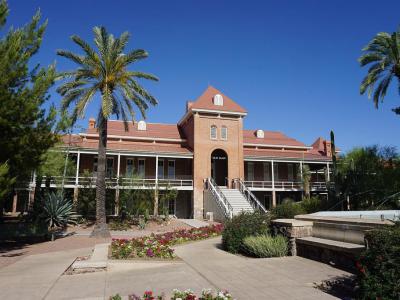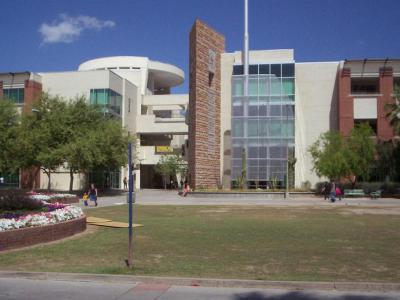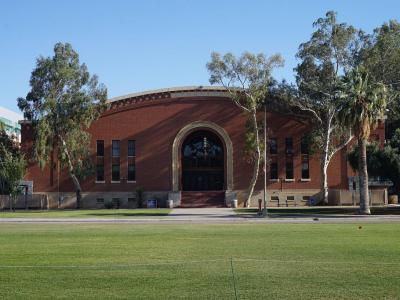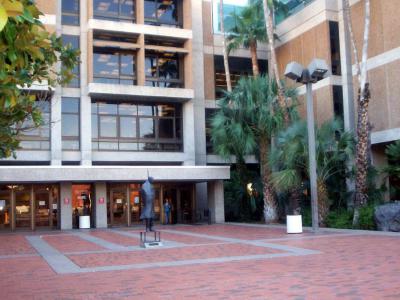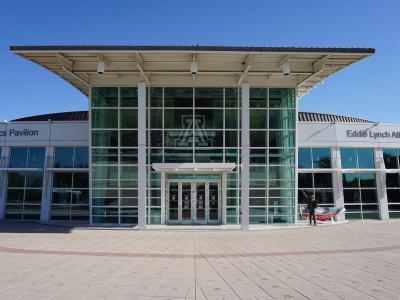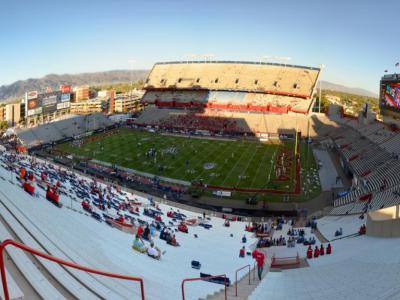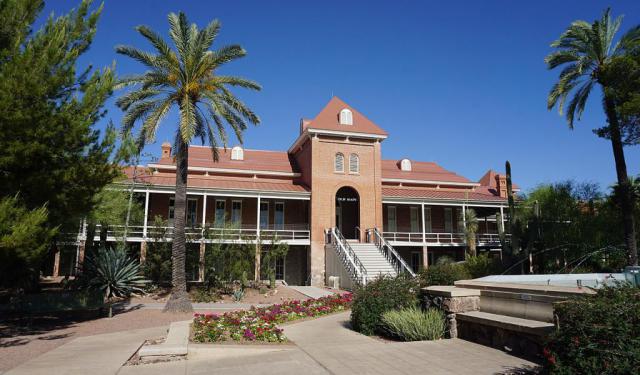
University of Arizona Walking Tour (Self Guided), Tucson
Founded in 1885, the University of Arizona (U of A) was the first university in the state, and so far has been the only representative from the state of Arizona in the Association of American Universities.
The U of A campus in Tucson proudly showcases a number of landmarks, each with its own story and unique allure. Among these, the Old Main building, an architectural gem, completed in 1891, stands as an enduring testament to the university's time-honored legacy.
Nestled at the heart of the campus, the Student Union Memorial Center is the central hub of student life. This building exudes an air of sophistication, a harmonious fusion of modernity and tradition.
The Bear Down Gym, the ex-home of the U of A's basketball team, is another historic venue on the campus. An embodiment of athletic prowess and spirited competition, this gymnasium has witnessed many memorable athletic events.
The University of Arizona Main Library, a modern-looking temple of knowledge, beckons those with inquisitive minds (like students and scholars) with its vast troves of intellectual treasures. Here, in the midst of towering bookshelves and the whispers of eager readers, the academic pursuit finds its truest expression.
Rising splendidly against the skyline, the McKale Center, the university's primary sports arena, stands as a grand testament to the fusion of sportsmanship and community pride. Within its state-of-the-art confines, thunderous applause and the roar of passionate fans reverberate, creating an electric atmosphere that ignites the spirits of athletes and spectators alike.
The Student Recreation Center, a sanctuary for holistic well-being, epitomizes a commitment to fostering the physical and mental wellness of the university community. An embodiment of modernity and cutting-edge facilities, this architectural masterpiece embraces a philosophy of balance and vitality.
Lastly, looming majestically Arizona Stadium is an awe-inspiring colosseum dedicated to the roaring passion of collegiate football. As the celebrated ground where the thundering clash of titans has been unfolding since 1929, this legendary arena unites a sea of devoted fans in a collective symphony of pride and camaraderie.
Together, these remarkable attractions foster an atmosphere of intellectual vibrancy, spirited competition, and holistic well-being that resonates throughout the University of Arizona in Tucson, enriching the lives of all who traverse its storied pathways. Now, you can have a good look around the U of A campus too by taking this self-guided walking tour.
The U of A campus in Tucson proudly showcases a number of landmarks, each with its own story and unique allure. Among these, the Old Main building, an architectural gem, completed in 1891, stands as an enduring testament to the university's time-honored legacy.
Nestled at the heart of the campus, the Student Union Memorial Center is the central hub of student life. This building exudes an air of sophistication, a harmonious fusion of modernity and tradition.
The Bear Down Gym, the ex-home of the U of A's basketball team, is another historic venue on the campus. An embodiment of athletic prowess and spirited competition, this gymnasium has witnessed many memorable athletic events.
The University of Arizona Main Library, a modern-looking temple of knowledge, beckons those with inquisitive minds (like students and scholars) with its vast troves of intellectual treasures. Here, in the midst of towering bookshelves and the whispers of eager readers, the academic pursuit finds its truest expression.
Rising splendidly against the skyline, the McKale Center, the university's primary sports arena, stands as a grand testament to the fusion of sportsmanship and community pride. Within its state-of-the-art confines, thunderous applause and the roar of passionate fans reverberate, creating an electric atmosphere that ignites the spirits of athletes and spectators alike.
The Student Recreation Center, a sanctuary for holistic well-being, epitomizes a commitment to fostering the physical and mental wellness of the university community. An embodiment of modernity and cutting-edge facilities, this architectural masterpiece embraces a philosophy of balance and vitality.
Lastly, looming majestically Arizona Stadium is an awe-inspiring colosseum dedicated to the roaring passion of collegiate football. As the celebrated ground where the thundering clash of titans has been unfolding since 1929, this legendary arena unites a sea of devoted fans in a collective symphony of pride and camaraderie.
Together, these remarkable attractions foster an atmosphere of intellectual vibrancy, spirited competition, and holistic well-being that resonates throughout the University of Arizona in Tucson, enriching the lives of all who traverse its storied pathways. Now, you can have a good look around the U of A campus too by taking this self-guided walking tour.
How it works: Download the app "GPSmyCity: Walks in 1K+ Cities" from Apple App Store or Google Play Store to your mobile phone or tablet. The app turns your mobile device into a personal tour guide and its built-in GPS navigation functions guide you from one tour stop to next. The app works offline, so no data plan is needed when traveling abroad.
University of Arizona Walking Tour Map
Guide Name: University of Arizona Walking Tour
Guide Location: USA » Tucson (See other walking tours in Tucson)
Guide Type: Self-guided Walking Tour (Sightseeing)
# of Attractions: 7
Tour Duration: 2 Hour(s)
Travel Distance: 2.8 Km or 1.7 Miles
Author: naomi
Sight(s) Featured in This Guide:
Guide Location: USA » Tucson (See other walking tours in Tucson)
Guide Type: Self-guided Walking Tour (Sightseeing)
# of Attractions: 7
Tour Duration: 2 Hour(s)
Travel Distance: 2.8 Km or 1.7 Miles
Author: naomi
Sight(s) Featured in This Guide:
- Old Main (University of Arizona)
- Student Union Memorial Center (U of A)
- Bear Down Gym (U of A)
- University of Arizona Main Library
- McKale Center (U of A)
- Student Recreation Center (U of A)
- Arizona Stadium
1) Old Main (University of Arizona) (must see)
Old Main, University of Arizona, originally known as the University of Arizona, School of Agriculture building, was the first building constructed on the University of Arizona campus in Tucson, Arizona. Old Main is one of the oldest surviving educational structures in the western United States. It was placed on the National Register of Historic Places in 1972.
Designed by Phoenix architect James Miller Creighton, construction of Old Main began on October 27, 1887. The budget of $37,969 ran out before the roof was finished. When university officials discovered federal loans were available for agricultural schools, they renamed the building from the originally planned School of Mines to the School of Agriculture. Federal funding allowed completion of the building and it opened for the first class of the university on October 1, 1891. Old Main, then the only building on the campus, contained the classrooms, library, offices, and dorms. Six faculty taught 32 students in 1891.
In 1919, the Alexander Berger Memorial Fountain was constructed in front of Old Main. Berger funded the project as a memorial for 13 University of Arizona students who were killed in World War I, including his nephew. Completed for $5500, the fountain was dedicated on January 31, 1920 by General John J. "Blackjack" Pershing.
Due to neglect by the University, Old Main fell into disrepair and was condemned by the City of Tucson in 1938. Demolition was averted when the US Navy repaired the building in 1942, for use as a Naval Indoctrination Training School during World War II. The Navy then paid $20,000 in 1945 to turn it back into a functioning campus building.
The first floor of Old Main was restored and renovated in 2008 at a cost of $4.6 million. It then housed the University's Office of Admissions, Center for Exploratory Students, and the Dean of Student's Office. In January 2013, renovation of the entire building began — including a modernization of the interior spaces, replacing the roof, and framing the porch. It reopened before the 2014-15 academic year. In addition to extensive improvements, the Office of the President was relocated to Old Main.
Designed by Phoenix architect James Miller Creighton, construction of Old Main began on October 27, 1887. The budget of $37,969 ran out before the roof was finished. When university officials discovered federal loans were available for agricultural schools, they renamed the building from the originally planned School of Mines to the School of Agriculture. Federal funding allowed completion of the building and it opened for the first class of the university on October 1, 1891. Old Main, then the only building on the campus, contained the classrooms, library, offices, and dorms. Six faculty taught 32 students in 1891.
In 1919, the Alexander Berger Memorial Fountain was constructed in front of Old Main. Berger funded the project as a memorial for 13 University of Arizona students who were killed in World War I, including his nephew. Completed for $5500, the fountain was dedicated on January 31, 1920 by General John J. "Blackjack" Pershing.
Due to neglect by the University, Old Main fell into disrepair and was condemned by the City of Tucson in 1938. Demolition was averted when the US Navy repaired the building in 1942, for use as a Naval Indoctrination Training School during World War II. The Navy then paid $20,000 in 1945 to turn it back into a functioning campus building.
The first floor of Old Main was restored and renovated in 2008 at a cost of $4.6 million. It then housed the University's Office of Admissions, Center for Exploratory Students, and the Dean of Student's Office. In January 2013, renovation of the entire building began — including a modernization of the interior spaces, replacing the roof, and framing the porch. It reopened before the 2014-15 academic year. In addition to extensive improvements, the Office of the President was relocated to Old Main.
Sight description based on Wikipedia.
2) Student Union Memorial Center (U of A)
The University of Arizona Student Union Memorial Center, commonly referred to as the SUMC, is a hub of student activity on the campus of the University of Arizona in Tucson, Arizona. This multi-level building offers a wide range of services and amenities for students, including dining options, study spaces, a theater, a game room, meeting rooms, and more.
During the 1960s and 1970s, the SUMC was a center for student activism and political demonstrations.
In 1969, the SUMC was the site of a 3-day sit-in by students protesting the university's involvement in the Vietnam War. The sit-in culminated in a confrontation between the students and the police, with over 50 students arrested.
In 1971, the SUMC was also the site of a protest against the visit of then-President Richard Nixon. Students gathered on the lawn outside the SUMC, chanting and holding signs, while Nixon addressed a crowd inside.
Today, the SUMC continues to be a center for student activities, housing student organizations, a food court, a bowling alley, a movie theater, and a variety of other services and resources.
During the 1960s and 1970s, the SUMC was a center for student activism and political demonstrations.
In 1969, the SUMC was the site of a 3-day sit-in by students protesting the university's involvement in the Vietnam War. The sit-in culminated in a confrontation between the students and the police, with over 50 students arrested.
In 1971, the SUMC was also the site of a protest against the visit of then-President Richard Nixon. Students gathered on the lawn outside the SUMC, chanting and holding signs, while Nixon addressed a crowd inside.
Today, the SUMC continues to be a center for student activities, housing student organizations, a food court, a bowling alley, a movie theater, and a variety of other services and resources.
3) Bear Down Gym (U of A)
Bear Down Gym, originally known as Men's Gymnasium, is a 300-seat multi-purpose arena on the campus of University of Arizona. It opened in 1926. It was originally home to the University of Arizona Wildcats basketball team. The basketball team moved to the McKale Center when it opened in 1973. Bear Down Gym is located at the center of the university campus and is recognized as one of university's most historical sites. The building was added to the list the National Register of Historic Places in 1990.
The name "Bear Down" came from the famed multi-sport student athlete named John “Button” Salmon. Salmon got into a car devastating car accident in 1926. The last words from Salmon before he died was “… tell the team to bear down”. The saying and story of "Bear Down" has since been a huge part of the athletics at the University of Arizona.
Bear Down Gym gained national attention for its inclusion in the 1984 blockbuster film Revenge of the Nerds. It was the gymnasium of the fictional "Adams College" and also temporary home to the Nerds after they were kicked out of their original Freshmen home (Cochise Hall).
The building has been renovated and updated to accommodate the growing needs of University of Arizona students, including housing resources for students such as the Think Tank, where students are tutored.
The name "Bear Down" came from the famed multi-sport student athlete named John “Button” Salmon. Salmon got into a car devastating car accident in 1926. The last words from Salmon before he died was “… tell the team to bear down”. The saying and story of "Bear Down" has since been a huge part of the athletics at the University of Arizona.
Bear Down Gym gained national attention for its inclusion in the 1984 blockbuster film Revenge of the Nerds. It was the gymnasium of the fictional "Adams College" and also temporary home to the Nerds after they were kicked out of their original Freshmen home (Cochise Hall).
The building has been renovated and updated to accommodate the growing needs of University of Arizona students, including housing resources for students such as the Think Tank, where students are tutored.
Sight description based on Wikipedia.
4) University of Arizona Main Library
The University of Arizona Main Library is the largest academic library in the state of Arizona. With a collection of over seven million books, journals, maps, government documents, and multimedia materials, the library is a vital resource for students, faculty, and researchers.
The building itself is an impressive sight, with its soaring atrium, modern design, and spacious reading rooms. In addition to its extensive collection, the Main Library offers a wide range of services, including research assistance, interlibrary loan, and access to digital resources.
One interesting story about the University of Arizona Main Library is that it was actually built on the site of a former football stadium. In the early 1960s, the University of Arizona was in need of a new library to accommodate its growing collection of books and other materials. At the time, the school's football stadium, known as Arizona Stadium, was located on the site where the library now stands.
Rather than constructing a completely new building from scratch, university officials decided to renovate the existing stadium and convert it into a modern library. The renovation involved replacing the original seating bowl with stacks and reading rooms, and adding a five-story central atrium to create a spacious, open feel.
The resulting library, which opened in 1976, was a dramatic departure from the traditional academic libraries of the past, with its modern design, open spaces, and innovative use of natural light. Today, the University of Arizona Main Library is not only a vital resource for students and scholars, but also an iconic building that stands as a testament to the university's commitment to innovation and progress.
The building itself is an impressive sight, with its soaring atrium, modern design, and spacious reading rooms. In addition to its extensive collection, the Main Library offers a wide range of services, including research assistance, interlibrary loan, and access to digital resources.
One interesting story about the University of Arizona Main Library is that it was actually built on the site of a former football stadium. In the early 1960s, the University of Arizona was in need of a new library to accommodate its growing collection of books and other materials. At the time, the school's football stadium, known as Arizona Stadium, was located on the site where the library now stands.
Rather than constructing a completely new building from scratch, university officials decided to renovate the existing stadium and convert it into a modern library. The renovation involved replacing the original seating bowl with stacks and reading rooms, and adding a five-story central atrium to create a spacious, open feel.
The resulting library, which opened in 1976, was a dramatic departure from the traditional academic libraries of the past, with its modern design, open spaces, and innovative use of natural light. Today, the University of Arizona Main Library is not only a vital resource for students and scholars, but also an iconic building that stands as a testament to the university's commitment to innovation and progress.
5) McKale Center (U of A)
McKale Memorial Center is the home of the university's Wildcats basketball team. It is primarily used for basketball, but also has physical training and therapy facilities. The arena opened in February 1973 and has an official capacity of 14,644 spectators.
The McKale Center was named in honor of J.F. "Pop" McKale, a major athletic figure at U of A from 1914 to 1957. At one time, he was head coach of all of the school's athletic teams. He was head basketball coach from 1914 to 1921, where he achieved a 49–12 (.803) record. He led the football team from 1914 to 1930, with an 80–32–6 (.703) record. It was McKale's first team that resulted in Arizona's teams being nicknamed "Wildcats." In 1914, Arizona's name meant very little in the college football world. Although they lost to Occidental College in Los Angeles 14–0, a reporter for the Los Angeles Times was so impressed with Arizona's effort that he wrote, "The Arizona men showed the fight of wild cats". Soon afterward, Arizona's student-athletes were nicknamed the Wildcats.
In terms of capacity, McKale Center is the second-largest arena in the Pac-12 conference; Utah's Huntsman Center in Salt Lake City is first, but Arizona averages greater attendance.
The McKale Center was named in honor of J.F. "Pop" McKale, a major athletic figure at U of A from 1914 to 1957. At one time, he was head coach of all of the school's athletic teams. He was head basketball coach from 1914 to 1921, where he achieved a 49–12 (.803) record. He led the football team from 1914 to 1930, with an 80–32–6 (.703) record. It was McKale's first team that resulted in Arizona's teams being nicknamed "Wildcats." In 1914, Arizona's name meant very little in the college football world. Although they lost to Occidental College in Los Angeles 14–0, a reporter for the Los Angeles Times was so impressed with Arizona's effort that he wrote, "The Arizona men showed the fight of wild cats". Soon afterward, Arizona's student-athletes were nicknamed the Wildcats.
In terms of capacity, McKale Center is the second-largest arena in the Pac-12 conference; Utah's Huntsman Center in Salt Lake City is first, but Arizona averages greater attendance.
6) Student Recreation Center (U of A)
The University of Arizona Student Recreation Center, also known as the "Rec Center," is a state-of-the-art fitness and wellness facility located on the University of Arizona campus. The center serves as a hub for physical fitness and wellness activities for students, faculty, and staff, offering a wide range of amenities and services for its members.
The University of Arizona Student Recreation Center, commonly known as the "Rec Center," has a rich history dating back to 1920 when the university first established a physical education program. At that time, the program was housed in an old army barracks that had been converted into a gymnasium.
Over the years, the program and its facilities continued to grow and evolve, with the construction of several new buildings and additions to the original gymnasium. In 1988, the current Student Recreation Center was built, replacing the aging facilities.
The Rec Center has become an integral part of campus life, offering a wide range of recreational activities and services for students, faculty, and staff. The facility includes an Olympic-sized swimming pool, multiple basketball and volleyball courts, weight and cardio rooms, indoor track, climbing wall, and more.
Today, the University of Arizona Student Recreation Center is one of the largest and most comprehensive recreation centers in the country, serving as a model for other universities and organizations.
The University of Arizona Student Recreation Center, commonly known as the "Rec Center," has a rich history dating back to 1920 when the university first established a physical education program. At that time, the program was housed in an old army barracks that had been converted into a gymnasium.
Over the years, the program and its facilities continued to grow and evolve, with the construction of several new buildings and additions to the original gymnasium. In 1988, the current Student Recreation Center was built, replacing the aging facilities.
The Rec Center has become an integral part of campus life, offering a wide range of recreational activities and services for students, faculty, and staff. The facility includes an Olympic-sized swimming pool, multiple basketball and volleyball courts, weight and cardio rooms, indoor track, climbing wall, and more.
Today, the University of Arizona Student Recreation Center is one of the largest and most comprehensive recreation centers in the country, serving as a model for other universities and organizations.
7) Arizona Stadium
Arizona Stadium is an outdoor college football stadium on the campus of the University of Arizona. It is the home field of the Arizona Wildcats of the Pac-12 Conference.
Originally constructed in 1929 to hold 7,000 spectators, the stadium's seating capacity has been expanded numerous times since. Today the stadium has a total capacity of over 50,000. The facility also includes the offices of the Wildcat football program, as well as some non-athletic academic offices, including the Steward Observatory Mirror Lab.
The football field runs in the traditional north–south configuration and the new artificial Field Turf sits at an elevation of 2,430 feet (740 m) above sea level. The ZonaZoo student section takes up 9,000 seats on lower east sideline, making it one of the larger student sections in the Pac-12. The west side bleachers are generally reserved for season ticket holders and the visiting team gets a section in the southwest corner.
Originally constructed in 1929 to hold 7,000 spectators, the stadium's seating capacity has been expanded numerous times since. Today the stadium has a total capacity of over 50,000. The facility also includes the offices of the Wildcat football program, as well as some non-athletic academic offices, including the Steward Observatory Mirror Lab.
The football field runs in the traditional north–south configuration and the new artificial Field Turf sits at an elevation of 2,430 feet (740 m) above sea level. The ZonaZoo student section takes up 9,000 seats on lower east sideline, making it one of the larger student sections in the Pac-12. The west side bleachers are generally reserved for season ticket holders and the visiting team gets a section in the southwest corner.
Sight description based on Wikipedia.
Walking Tours in Tucson, Arizona
Create Your Own Walk in Tucson
Creating your own self-guided walk in Tucson is easy and fun. Choose the city attractions that you want to see and a walk route map will be created just for you. You can even set your hotel as the start point of the walk.
Tucson Architecture Walking Tour
Just as any city is not an accident but the result of coherent visions and aims, Tucson's architectural landscape bears witness to the city's profound historical narrative and cultural melange.
From the majestic belfries of the Saint Augustine Cathedral, adorned with the Spanish Colonial Revival-style opulence, to the resplendent Scottish Rite Cathedral (also known as the Masonic... view more
Tour Duration: 1 Hour(s)
Travel Distance: 2.1 Km or 1.3 Miles
From the majestic belfries of the Saint Augustine Cathedral, adorned with the Spanish Colonial Revival-style opulence, to the resplendent Scottish Rite Cathedral (also known as the Masonic... view more
Tour Duration: 1 Hour(s)
Travel Distance: 2.1 Km or 1.3 Miles
Tucson Downtown Walking Tour
Known as “The Old Pueblo” and “Optics Valley,” Tucson, Arizona, is "America's biggest small town" boasting a rich history and global recognition for its contributions to optical science and telescope technology.
The Spanish name, Tucson, is derived from the Uto-Aztecan language, meaning "at the foot of the black hill" – a nod to Sentinel Peak's basalt... view more
Tour Duration: 2 Hour(s)
Travel Distance: 3.0 Km or 1.9 Miles
The Spanish name, Tucson, is derived from the Uto-Aztecan language, meaning "at the foot of the black hill" – a nod to Sentinel Peak's basalt... view more
Tour Duration: 2 Hour(s)
Travel Distance: 3.0 Km or 1.9 Miles
The Most Popular Cities
/ view all
